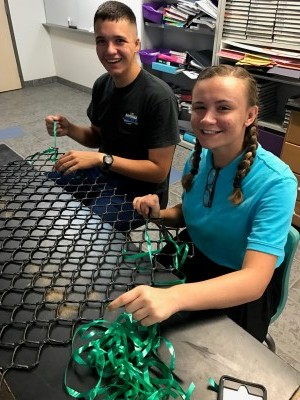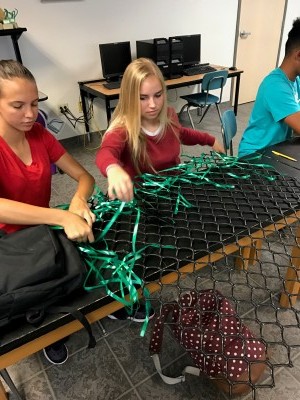Space Coast students make artificial seagrass beds for reef fish study in the Florida Keys
More than 170 students from Space Coast Junior/Senior High School in Cocoa, Florida, built artificial seagrass mats over the past week for a Mote Marine Laboratory study planned for this summer in the Florida Keys.
Scientists suspect that patchy coral reefs of Florida and Caribbean have healthier fish communities if seagrass beds are nearby, since many juvenile fish start their lives among seagrasses and move to reefs later. However, many reefs have a “halo” of empty sand, where reef fishes have eaten the seagrasses and fled back to the reef to hide from predators. This halo could be a tough barrier to young fish, giving them nowhere to hide between seagrass nursery and reef.
Theoretically, if scientists fill that gap with artificial seagrass, young fish might be more willing to cross to reefs under their cover and be less likely to be eaten during crossing.
Mote Postdoctoral Research Fellow Dr. Rob Nowicki and colleagues will test this hypothesis with a one-year study starting in June 2017 in the lower Florida Keys Reef Tract between Summerland Key and Key West.
Nowicki needed help building artificial seagrass mats — and the Space Coast students were happy to lend a hand.
“I put together a presentation about corals, and the research to study coral reefs and seagrass beds,” said Jennifer Cotton, Marine Science teacher at Space Coast Junior/Senior High School. “We got the students started, working on artificial seagrass mats, and they are moving fast — we should be done within a week. This kind of project allows the students to put their hands on something real, to do something that may inspire them to keep working in the field. The students enjoy getting to be part of a new study that hasn’t been done here before.”


Above left image: Jeremy Brockwell and Kearston Eberhardt. Above right image: Shandi Schmitt (left) and Adrianna Patracone. Credit: Space Coast Junior/Senior High School.
“It’s always interesting to do a marine focused project, but it’s especially interesting to learn about reefs and seagrass in the Florida Keys because this is close to where we live,” said Space Coast senior Savannah Bowen.
Though Bowen acknowledged the process was tedious – tying lots of green party ribbon onto a plastic frame to mock up seagrass beds – she said the subject matter was inspiring and useful. “I hope I can point to this experience in the future, since I want to go into marine biology.”
10th grader Rachel Trull added: “We’re looking at how to make this a healthy ecosystem. This is giving me ideas of the kind of work I could do in the future.”
“It’s a cool project, putting these seagrass mats to see if we can help fish cross to the reef. I’m glad I got to help with it,” said senior Samantha Hurst.
“If these artificial seagrass beds have the expected effect, helping encourage fish cross the dangerous sandy halo around the reef, it tells us that close proximity to seagrass is important for this kind of reef,” Nowicki said. “That could mean reefs with seagrass right next to them might be among the best places for coral restoration. Also, it could mean that more seagrass beds could help jump-start fish recruitment. We care about having fish on the reef because people like to eat some reef fish species, and others control algae that can out-compete coral. Healthy coral reefs need healthy reef fish communities.”
